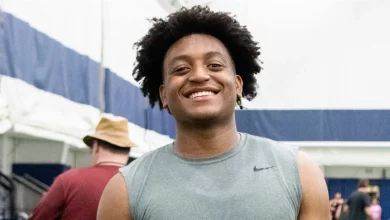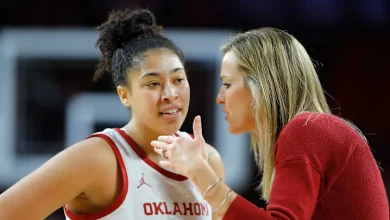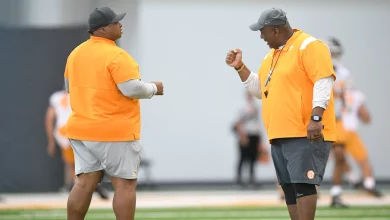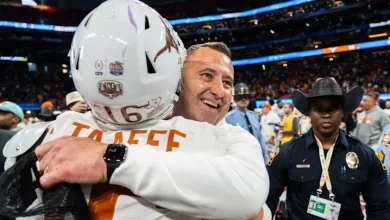Mailbox: Did Jim Knowles leave Ohio State for a reason other than being a “gunslinger”?
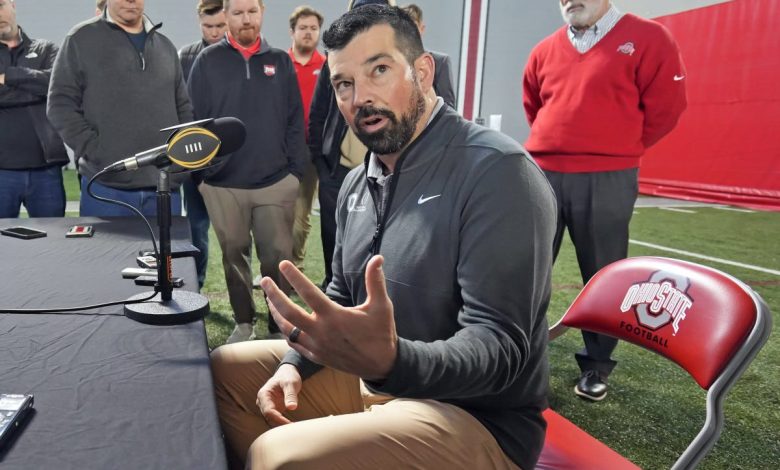
In the world of college football, coaching changes and moves are frequent, and the reasoning behind a coach’s decision to leave a program can often spark intense debate. This topic has been especially relevant in recent years for Jim Knowles, who served as the defensive coordinator at Ohio State and garnered significant attention for his aggressive defensive schemes. Recently, a question has emerged: Did Jim Knowles leave Ohio State for reasons beyond his reputation as a “gunslinger,” a label that’s often associated with a coach’s risk-taking and aggressive mentality? This article aims to explore this question, analyzing not only Knowles’ playing style but also the broader context of his departure, potential motivations, and the long-term implications of his move.
A History of Aggressive Coaching: The “Gunslinger” Label
Before delving into the specifics of Jim Knowles’ departure from Ohio State, it’s important to understand the background of the coach and why he has been labeled a “gunslinger.” This term is typically used to describe a coach who employs an aggressive, high-risk style of play, particularly on defense. “Gunslingers” are known for their willingness to send extra rushers after the quarterback, pressuring opposing offenses with complex blitzes and schemes that prioritize creating turnovers and making big plays. While this style can lead to great rewards, it also comes with a significant amount of risk, as leaving gaps in the defense can expose a team to big plays if the pressure doesn’t reach the quarterback in time.
Jim Knowles’ defensive philosophy, which was widely embraced during his time at Oklahoma State before coming to Ohio State, embodied this “gunslinger” mentality. He was known for his innovative approach to defensive schemes, often employing a 4-2-5 alignment with multiple safety blitzes, complex zone coverages, and an overall aggressive approach to disrupting the opposing offense. His defensive units thrived on creating chaos and forcing mistakes from quarterbacks, putting the defense in high-risk, high-reward situations.
When Knowles took over as the defensive coordinator at Ohio State in 2022, it was with the expectation that his aggressive defensive style would make a significant impact. The Buckeyes had a talented roster, and their offense was firing on all cylinders. However, their defense had been a weak link in previous seasons, allowing big plays and being vulnerable to fast-paced offenses. The hope was that Knowles’ aggressive scheme would help close this gap and give the Buckeyes the edge they needed to win a national title.
However, the “gunslinger” mentality didn’t always translate as expected. While the defense showed flashes of brilliance, particularly in forcing turnovers, it also became prone to being burned by big plays and vulnerable in crucial moments. The high-risk nature of Knowles’ scheme sometimes exposed Ohio State’s defensive weaknesses, and by the end of the 2023 season, there were questions about whether Knowles’ approach was the right fit for the team. Despite having top-tier talent at all levels of the defense, Ohio State was still occasionally victimized by explosive offenses, and they were eliminated in the College Football Playoff by a team with a more conservative, balanced approach.
The Departure: What Prompted Jim Knowles’ Exit?
In light of the inconsistent results, the question arises: Why did Jim Knowles leave Ohio State after just two seasons? Was it simply a matter of his “gunslinger” mentality not meshing with the program, or were there deeper factors at play?
First and foremost, Knowles’ decision to leave Ohio State was not a sudden one. There had been rumblings in the college football world about his future with the Buckeyes in the aftermath of their playoff loss. Ohio State fans and analysts had begun to scrutinize his defensive approach, especially after the Buckeyes’ struggles in big games. Ohio State has long been considered one of the elite programs in the country, and the pressure to compete for a national championship year after year is immense. While Knowles’ defense was statistically sound in many respects, the breakdowns in crucial moments raised doubts about whether his aggressive approach could deliver consistent success in the biggest games.
Despite these struggles, it’s important to recognize that Knowles is a highly respected coach with a proven track record. Prior to his tenure at Ohio State, Knowles had spent several seasons as the defensive coordinator at Oklahoma State, where he built one of the best defenses in the Big 12. Under his leadership, Oklahoma State consistently ranked near the top in total defense, sacks, and turnovers, and Knowles was widely regarded as one of the top defensive minds in college football. So, the question of whether he left due to a lack of success at Ohio State is complicated. Was his exit truly a result of failing to meet expectations, or were other factors, such as personal aspirations or professional opportunities, at play?
Personal Aspirations: Seeking a Bigger Challenge
One possibility is that Knowles simply reached a point in his career where he was looking for a new challenge. Coaching at Ohio State, a program with such high expectations, is no easy task, and Knowles might have felt the pressure of the job weighing on him. It’s possible that, despite the positive strides made by his defense, Knowles realized that his particular style was not going to take Ohio State to the promised land of national championships.
Knowles’ departure could be indicative of his personal aspirations to prove himself elsewhere. For many coaches, the opportunity to test their mettle in a new program with different resources, different expectations, and different challenges can be an enticing prospect. Perhaps Knowles felt that, after two seasons at Ohio State, his work was done, and he was ready for a new challenge, where he could tweak or reimagine his defensive strategies without the pressure of being associated with a legacy of championship expectations.
The Impact of Ohio State’s Expectations on Coaching Decisions
Another factor to consider is the sheer weight of expectations at Ohio State. The Buckeyes have been an elite program for decades, consistently competing for Big Ten championships and national titles. The pressure to win immediately at a program like Ohio State is enormous, and for a coach who is as dedicated to his craft as Knowles is, that pressure can become overwhelming.
Knowles entered Ohio State with the understanding that he was expected to fix the Buckeyes’ defense and turn it into a championship-caliber unit. While he did make some progress in this area, particularly in terms of forcing turnovers, the big-play vulnerability of his defense was a critical flaw. This led to criticism, particularly from Ohio State fans and analysts who had high expectations for the team’s performance in big games. The external pressure on Knowles’ performance could have been a deciding factor in his exit, as coaches often feel the need to leave programs where expectations and realities do not align.
Moreover, Ohio State has a long history of excellent defensive coordinators, and the bar is set high for anyone who takes on the role. From Luke Fickell to Greg Schiano, past defensive coordinators have been expected to lead Ohio State’s defense to the top of the rankings. With the weight of this legacy, Knowles might have felt that he couldn’t live up to those expectations, particularly when his defensive scheme was sometimes outmatched by the more conservative, balanced approaches seen in other top programs.
Was the “Gunslinger” Mentality a Part of the Problem?
While it’s clear that several factors likely contributed to Knowles’ decision to leave, it’s important to examine whether his aggressive “gunslinger” mentality played a more significant role in his departure than initially thought. Knowles’ defensive schemes have been compared to that of a “gunslinger,” constantly pushing the envelope and taking risks. While this can work well for a team with elite talent, it can also backfire when the team is not able to execute perfectly or when facing offenses that capitalize on defensive mistakes.
Ohio State’s defense had moments where Knowles’ style seemed to work perfectly, especially when his defense was able to pressure quarterbacks and force turnovers. However, when the pressure wasn’t applied effectively, Ohio State’s defense could be exploited. Against offenses with efficient quarterbacks and skilled playmakers, Knowles’ aggressive blitzing and coverage schemes left too many gaps, and the defense became vulnerable to big plays, particularly in high-stakes games like the College Football Playoff.
Could the “gunslinger” mentality have led to Knowles feeling that his defense wasn’t the right fit for Ohio State? Did he feel the need to adjust his philosophy or find a new environment where his style could shine without the same level of scrutiny? While these are speculative questions, they are worth considering when analyzing Knowles’ departure.
Conclusion: A Complex Departure with Many Layers
Ultimately, Jim Knowles’ decision to leave Ohio State is a complex one, shaped by multiple factors. While his reputation as a “gunslinger” may have contributed to some of the struggles Ohio State faced defensively, it would be an oversimplification to attribute his exit solely to this aggressive coaching style. Knowles is a highly respected defensive mind, and his time at Ohio State was marked by some notable successes. However, the pressure to meet championship expectations, the limitations of his defensive approach, and his personal aspirations likely all played a role in his decision to leave.
As college football continues to evolve, coaches like Knowles will always be in high demand, and his next move will likely be just as scrutinized as his time at Ohio State. For now, Ohio State will continue to rebuild and search for a defensive coordinator who can meet the high standards of the program, while Knowles will undoubtedly continue to be a key figure in the future of college football.
decision to leave a program can often spark intense debate. This topic has been especially relevant in recent years for Jim Knowles, who served as the defensive coordinator at Ohio State and garnered significant attention for his aggressive defensive schemes. Recently, a question has emerged: Did Jim Knowles leave Ohio State for reasons beyond his reputation as a “gunslinger,” a label that’s often associated with a coach’s risk-taking and aggressive mentality? This article aims to explore this question, analyzing not only Knowles’ playing style but also the broader context of his departure, potential motivations, and the long-term implications of his move.
A History of Aggressive Coaching: The “Gunslinger” Label
Before delving into the specifics of Jim Knowles’ departure from Ohio State, it’s important to understand the background of the coach and why he has been labeled a “gunslinger.” This term is typically used to describe a coach who employs an aggressive, high-risk style of play, particularly on defense. “Gunslingers” are known for their willingness to send extra rushers after the quarterback, pressuring opposing offenses with complex blitzes and schemes that prioritize creating turnovers and making big plays. While this style can lead to great rewards, it also comes with a significant amount of risk, as leaving gaps in the defense can expose a team to big plays if the pressure doesn’t reach the quarterback in time.
Jim Knowles’ defensive philosophy, which was widely embraced during his time at Oklahoma State before coming to Ohio State, embodied this “gunslinger” mentality. He was known for his innovative approach to defensive schemes, often employing a 4-2-5 alignment with multiple safety blitzes, complex zone coverages, and an overall aggressive approach to disrupting the opposing offense. His defensive units thrived on creating chaos and forcing mistakes from quarterbacks, putting the defense in high-risk, high-reward situations.
When Knowles took over as the defensive coordinator at Ohio State in 2022, it was with the expectation that his aggressive defensive style would make a significant impact. The Buckeyes had a talented roster, and their offense was firing on all cylinders. However, their defense had been a weak link in previous seasons, allowing big plays and being vulnerable to fast-paced offenses. The hope was that Knowles’ aggressive scheme would help close this gap and give the Buckeyes the edge they needed to win a national title.
However, the “gunslinger” mentality didn’t always translate as expected. While the defense showed flashes of brilliance, particularly in forcing turnovers, it also became prone to being burned by big plays and vulnerable in crucial moments. The high-risk nature of Knowles’ scheme sometimes exposed Ohio State’s defensive weaknesses, and by the end of the 2023 season, there were questions about whether Knowles’ approach was the right fit for the team. Despite having top-tier talent at all levels of the defense, Ohio State was still occasionally victimized by explosive offenses, and they were eliminated in the College Football Playoff by a team with a more conservative, balanced approach.
The Departure: What Prompted Jim Knowles’ Exit?
In light of the inconsistent results, the question arises: Why did Jim Knowles leave Ohio State after just two seasons? Was it simply a matter of his “gunslinger” mentality not meshing with the program, or were there deeper factors at play?
First and foremost, Knowles’ decision to leave Ohio State was not a sudden one. There had been rumblings in the college football world about his future with the Buckeyes in the aftermath of their playoff loss. Ohio State fans and analysts had begun to scrutinize his defensive approach, especially after the Buckeyes’ struggles in big games. Ohio State has long been considered one of the elite programs in the country, and the pressure to compete for a national championship year after year is immense. While Knowles’ defense was statistically sound in many respects, the breakdowns in crucial moments raised doubts about whether his aggressive approach could deliver consistent success in the biggest games.
Despite these struggles, it’s important to recognize that Knowles is a highly respected coach with a proven track record. Prior to his tenure at Ohio State, Knowles had spent several seasons as the defensive coordinator at Oklahoma State, where he built one of the best defenses in the Big 12. Under his leadership, Oklahoma State consistently ranked near the top in total defense, sacks, and turnovers, and Knowles was widely regarded as one of the top defensive minds in college football. So, the question of whether he left due to a lack of success at Ohio State is complicated. Was his exit truly a result of failing to meet expectations, or were other factors, such as personal aspirations or professional opportunities, at play?
Personal Aspirations: Seeking a Bigger Challenge
One possibility is that Knowles simply reached a point in his career where he was looking for a new challenge. Coaching at Ohio State, a program with such high expectations, is no easy task, and Knowles might have felt the pressure of the job weighing on him. It’s possible that, despite the positive strides made by his defense, Knowles realized that his particular style was not going to take Ohio State to the promised land of national championships.
Knowles’ departure could be indicative of his personal aspirations to prove himself elsewhere. For many coaches, the opportunity to test their mettle in a new program with different resources, different expectations, and different challenges can be an enticing prospect. Perhaps Knowles felt that, after two seasons at Ohio State, his work was done, and he was ready for a new challenge, where he could tweak or reimagine his defensive strategies without the pressure of being associated with a legacy of championship expectations.
The Impact of Ohio State’s Expectations on Coaching Decisions
Another factor to consider is the sheer weight of expectations at Ohio State. The Buckeyes have been an elite program for decades, consistently competing for Big Ten championships and national titles. The pressure to win immediately at a program like Ohio State is enormous, and for a coach who is as dedicated to his craft as Knowles is, that pressure can become overwhelming.
Knowles entered Ohio State with the understanding that he was expected to fix the Buckeyes’ defense and turn it into a championship-caliber unit. While he did make some progress in this area, particularly in terms of forcing turnovers, the big-play vulnerability of his defense was a critical flaw. This led to criticism, particularly from Ohio State fans and analysts who had high expectations for the team’s performance in big games. The external pressure on Knowles’ performance could have been a deciding factor in his exit, as coaches often feel the need to leave programs where expectations and realities do not align.
Moreover, Ohio State has a long history of excellent defensive coordinators, and the bar is set high for anyone who takes on the role. From Luke Fickell to Greg Schiano, past defensive coordinators have been expected to lead Ohio State’s defense to the top of the rankings. With the weight of this legacy, Knowles might have felt that he couldn’t live up to those expectations, particularly when his defensive scheme was sometimes outmatched by the more conservative, balanced approaches seen in other top programs.
Was the “Gunslinger” Mentality a Part of the Problem?
While it’s clear that several factors likely contributed to Knowles’ decision to leave, it’s important to examine whether his aggressive “gunslinger” mentality played a more significant role in his departure than initially thought. Knowles’ defensive schemes have been compared to that of a “gunslinger,” constantly pushing the envelope and taking risks. While this can work well for a team with elite talent, it can also backfire when the team is not able to execute perfectly or when facing offenses that capitalize on defensive mistakes.
Ohio State’s defense had moments where Knowles’ style seemed to work perfectly, especially when his defense was able to pressure quarterbacks and force turnovers. However, when the pressure wasn’t applied effectively, Ohio State’s defense could be exploited. Against offenses with efficient quarterbacks and skilled playmakers, Knowles’ aggressive blitzing and coverage schemes left too many gaps, and the defense became vulnerable to big plays, particularly in high-stakes games like the College Football Playoff.
Could the “gunslinger” mentality have led to Knowles feeling that his defense wasn’t the right fit for Ohio State? Did he feel the need to adjust his philosophy or find a new environment where his style could shine without the same level of scrutiny? While these are speculative questions, they are worth considering when analyzing Knowles’ departure.
A Complex Departure with Many Layers
Ultimately, Jim Knowles’ decision to leave Ohio State is a complex one, shaped by multiple factors. While his reputation as a “gunslinger” may have contributed to some of the struggles Ohio State faced defensively, it would be an oversimplification to attribute his exit solely to this aggressive coaching style. Knowles is a highly respected defensive mind, and his time at Ohio State was marked by some notable successes. However, the pressure to meet championship expectations, the limitations of his defensive approach, and his personal aspirations likely all played a role in his decision to leave.
As college football continues to evolve, coaches like Knowles will always be in high demand, and his next move will likely be just as scrutinized as his time at Ohio State. For now, Ohio State will continue to rebuild and search for a defensive coordinator who can meet the high standards of the program, while Knowles will undoubtedly continue to be a key figure in the future of college football.



